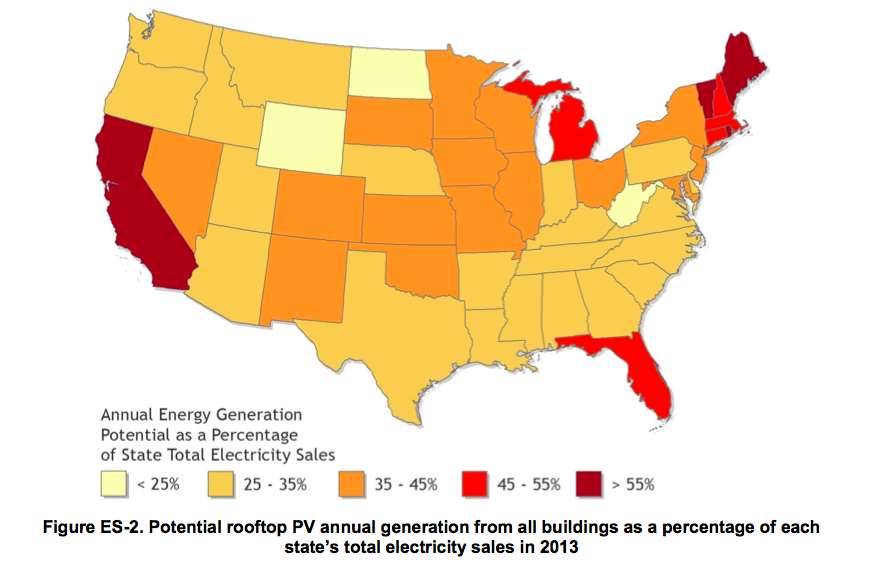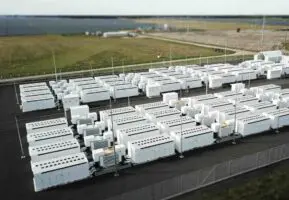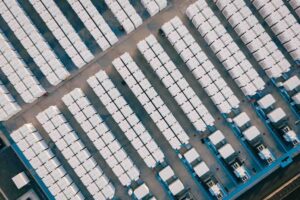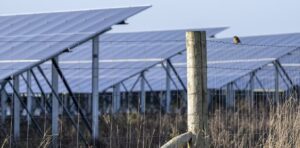A major new study has significantly lifted the potential of rooftop solar PV in the United States, saying rooftop solar alone could provide 40 per cent of all the electricity needs of the world’s biggest economy, and around half if module efficiencies continued to improve.
The study by the National Renewable Energy Laboratory says the estimated potential from rooftop solar has been revised upwards by more than 80 per cent since the last study in 2008, mostly because of improvements of module efficiencies, building availability and solar modelling.
In all, NREL estimates potential rooftop solar installed capacity at 1,118 gigawatts (GW) and generation of 1,432 terawatt-hours (TWh). This would account for 39 per cent of all electricity sales, but could go higher – to around 50 per cent – if higher module efficiencies were taken into account.
The report underlines the likely transition of the world’s major electricity systems from one dominated by central, fossil fuel generators, to a largely locally supplied pool of electricity, much of it from rooftop solar, augmented by storage and community based projects using solar and other technologies,
As this map above shows, the greatest potential for rooftop solar as a share of total electricity supply is in California, where NREL estimates it could supply 74 per cent of all demand.
A cluster of New England states – Maine, Vermont, Rhode Island, New Hampshire, Connecticut and Massachusetts – could generate more than 45 per cent of their electricity needs from rooftop solar PV, despite the below-average solar resource of these states.
The NREL says a common feature of the top six states – in terms of potential PV generation as a percentage of total sales – is the significantly below-average household consumption, suggesting the role an energy-efficient residential sector could play in achieving a high penetration of energy from rooftop PV.
The worst performing state – Wyoming – has the highest average households electricity consumption, at more than 30kWh a day.
NREL points out that these are not predictions, just potential output. But is also says its own estimates could be highly conservative.
Firstly, it uses an average module efficiency of 16 per cent, when most modern rooftop systems have efficiencies of around 20 per cent. If this average was used, it would lift its figures by around 25 per cent, meaning that rooftop solar had the potential to meet half the country’s electricity demand (and nearly 90 per cent in California).
The study also did not take into account the enormous potential of ground-mounted solar, nor did it take into account other installations such as car parks, or integrating solar PV into building facades. Only 26 per cent of “small rooftop” spaces were considered suitable for solar PV.
While the NREL study does only focus on the potential of rooftop solar capacity, many in the industry believe that rooftop solar costs will fall so much that installations will be at “saturation point” – meaning that they will be intalled on nearly every building available.
A study by the former WA energy market operator suggested that 70 per cent of all homes and 90 per cent of all businesses could install rooftop solar. Similar forecasts are made for South Australia.
Rooftop solar in both W.A. and S.A. is forecast to meet all of daytime demand in certain periods within the next decade, underlying the shift from the old-fashioned but long standing system of centralised “base load” generation to a localised system of “distributed energy”.
Institutions such as the CSIRO, and utilities such as RWE, E.ON, and Engie have all forecast that half of all electricity generation could be supplied locally within a few decades.
This includes rooftop solar and battery storage systems, but also “community” projects and micro-grids that might use other technologies too – such as wave, hydro, biomass and wind.












